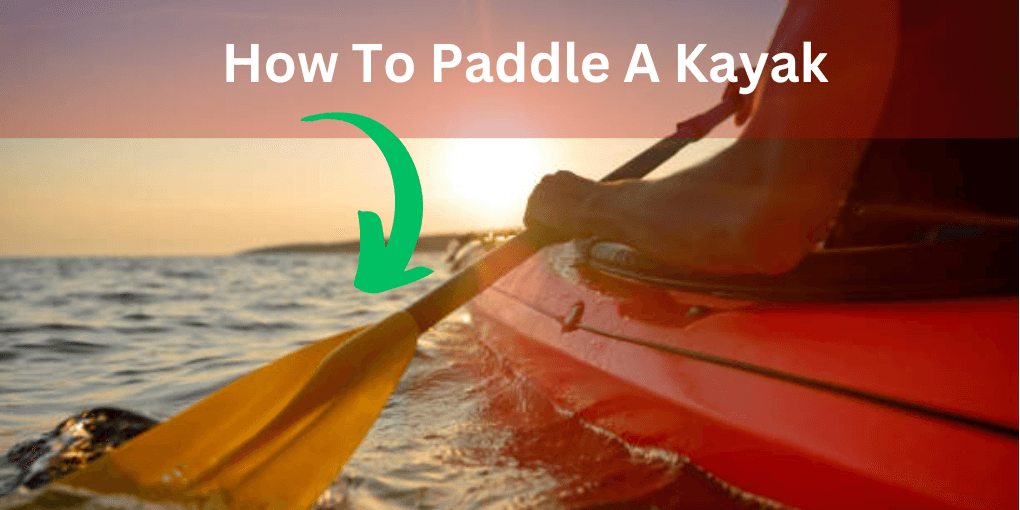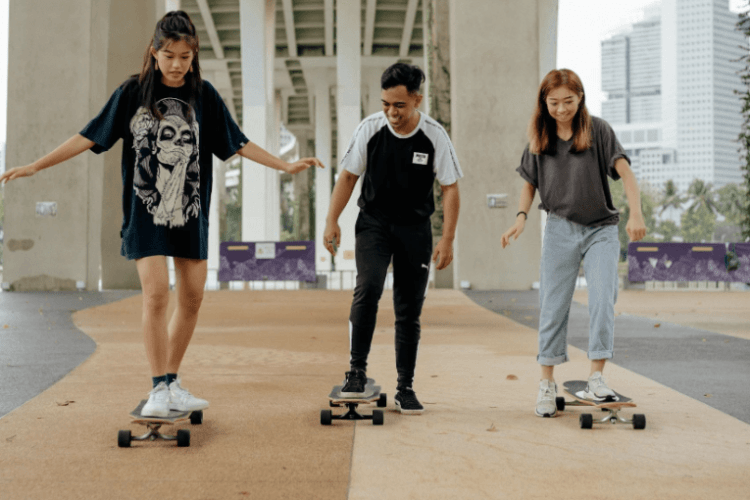How To Paddle A Kayak For Beginners: Paddle Like a Boss
Kayaking is a fun and exciting activity that allows you to explore the great outdoors and get up close to nature.

Whether you’re a beginner or an experienced kayaker, knowing kayak paddling is essential for both enjoyment and safety.
In this blog post, I’ll cover the key elements of how to paddle a kayak, including the basics of paddling.
You will also learn the forward stroke technique, turning a kayak, and bracing. By the end of this post, you’ll have the knowledge and skills to confidently navigate your kayak through any body of water.
So, let’s get started!
Importance of Knowing How to Paddle a Kayak
Knowing how to paddle a kayak is not only essential for enjoyment, but also for safety on the water.
Without proper knowledge and technique, you could put yourself and others in danger.
If you’re paddling incorrectly, you could capsize your kayak, get stranded in open water, or collide with other watercraft.
In addition to safety, knowing how to paddle correctly can enhance your experience on the water.
With proper technique, you can paddle faster with less effort. It allows you to cover greater distances and spend more time enjoying the scenery around you.
Furthermore, this learning can help you to avoid developing bad habits that can cause physical strain or injury over time.
The Basics of Paddling a Kayak
Before learning more advanced techniques, it’s important to master the basics of paddling a kayak.
This includes understanding the different parts of the paddle, proper grip, and correct positioning in the kayak.
Explanation of the Different Parts of a Kayak Paddle
A typical kayak paddle consists of the following parts:
- Blade: The flat, wide part of the paddle that enters the water.
- Shaft: A long, thin part of the paddle that you hold onto.
- Grip: This part of the paddle that you hold onto with your hands.
- Ferrule: The joint that connects the two halves of the paddle.
Proper Technique for Gripping the Paddle
To grip the paddle correctly, follow these steps:
- Hold the paddle with both hands, with your arms straight and your hands shoulder-width apart.
- Place your hands on the grip, with your knuckles facing up.
- Your hands should be positioned so that your thumbs point toward the blade.
Correct Positioning in the Kayak
Sitting in the correct position in the kayak is crucial for proper paddling technique. Here are some tips:
- Sit with your back straight and your feet flat on the footrests.
- Your knees should be slightly bent and your thighs should be in contact with the sides of the kayak.
- Make sure your hips are centered in the kayak.
These basic techniques will help you to learn more advanced paddling techniques.
Forward Stroke Technique
The forward stroke is the most fundamental and important kayaking maneuver. It’s used for propelling the kayak forward in a straight line. Here are the steps to perform the forward stroke:
Start with the Correct Grip and Posture
Before beginning the forward stroke, make sure your grip on the paddle is correct. You have to notice that your posture is upright with your shoulders relaxed.
Dip the Blade into the Water
Dip the blade of the paddle into the water on the side of the kayak opposite to the direction you want to go. Make sure the blade is fully submerged in the water.
Rotate your Torso
As you start to pull the paddle through the water, rotate your torso towards the side of the kayak with the blade in the water. This will provide more power to your stroke.
Pull the Blade Toward your Hip
Pull the blade towards your hip, keeping it as close to the kayak as possible. This will allow you to generate the most power and maintain a straight line.
Lift the Blade out of the Water
As you complete the stroke, lift the blade out of the water and return to the starting position. Make sure to repeat the stroke on the opposite side to maintain a straight course.
By mastering the forward stroke, you’ll be able to paddle and maintain control over your kayak. With practice, you’ll be able to build up speed and cover longer distances with less effort.
How to Paddle a Kayak
Kayaking can be a fun and exciting way to explore the water and get some exercise at the same time. Here are some basic steps on how to paddle a kayak:
- Get into the kayak: First, you’ll want to position the kayak so that it’s in shallow water. Sit down in the kayak and place your feet on the footrests.
- Hold the paddle: Hold the paddle with both hands, keeping your hands shoulder-width apart. The paddle’s concave side should be facing you.
- Position the paddle: Hold the paddle straight up and down in front of you, with your arms fully extended. It is best if the blades are pointed away from you.
- Begin paddling: Dip one blade of the paddle into the water, reaching as far forward as you can. Use a twisting motion with your torso to move the blade through the water, pulling the blade back towards you. When the blade is about level with your hip, lift it out of the water.
- Repeat on the other side: Once you’ve completed a stroke on one side, switch to the other side and repeat the process.
- Find a comfortable rhythm: When you’re being comfortable with the basic motion, focus on finding a perfect rhythm that feels natural to you. You may find that you prefer longer or shorter strokes, or that you need to adjust your grip on the paddle.
- Use your core muscles: As you paddle, engage your core muscles to generate power and stability. This will help you maintain your balance and propel the kayak forward more efficiently.
- Pay attention to your surroundings: Always be aware of your surroundings and adjust your paddling technique as needed. For example, you may need to paddle harder if you’re paddling against a current or in windy conditions.
Bracing
Bracing is a technique used to prevent the kayak from capsizing. It’s especially important when paddling in rough water or strong currents. Here’s how to perform a basic brace:
Keep your weight centered
When you feel the kayak tipping, keep your weight centered to prevent it from capsizing. Keep your torso upright and your paddle close to the kayak.
Place the blade on the surface of the water
Place the blade of the paddle on the surface of the water on the side opposite to the direction in which the kayak is tipping. Make sure the blade is flat and at a right angle to the kayak.
Apply Pressure to the Blade
Apply pressure to the blade by pushing down with your upper hand and pulling up with your lower hand. This will provide stability and prevent the kayak from capsizing.
Recover your Paddle
As the kayak stabilizes, recover your paddle and return to a normal paddling position.
Importance of Practicing Paddling Techniques
Practicing proper paddling techniques and safety precautions is important when it comes to kayaking. Here are some reasons why:
Safety: Kayaking can be a lot of fun, but it can also be dangerous if proper safety precautions are not taken. Knowing how to paddle a kayak and understanding basic safety measures can help prevent accidents and injuries.
Efficiency: Practicing proper paddling techniques can help you move through the water. This can help you conserve energy and cover greater distances. It makes your kayaking experience more enjoyable.
Control: Proper paddling techniques can help you maintain better control over your kayak. This is important in rough or unpredictable conditions, where being able to maneuver your kayak can help keep you safe.
Comfort: Using the right paddling techniques can also help prevent discomfort and fatigue. For example, using your core muscles to generate power can help take the strain off your arms and shoulders.
Environmental impact: Practicing good paddling techniques and safety measures can also help minimize your impact on the environment. Proper paddling methods and safety procedures can protect delicate water environments and species.
Safety Tips and Guidelines
Kayaking is a super fun adventure, but it’s important to stay safe on the water. Let’s learn some cool safety tips to make your kayaking experience awesome and safe.
1. Wear Your Life Jacket: Always wear a life jacket when you’re in a kayak. It’s like a superhero cape for the water! Life jackets keep you floating and safe, even if you’re a fantastic swimmer.
2. Buddy Up! Kayaking is more fun with a buddy. Stick together and look out for each other. Two paddlers are better than one.
3. Listen to the Captain (Adult): If there’s a grown-up with you, listen to them. They’re the captains of your kayak adventure and know how to keep everyone safe.
4. Know Your Gear: Before you hit the water, get to know your kayak and paddle. Check for any loose straps, make sure your paddle is the right size, and wiggle your kayak to make sure everything is snug.
5. Stay Close to Shore: Stick to the shallow areas near the shore, especially if you’re a beginner. It’s like training wheels for kayaking. As you get better, you can explore deeper waters!
6. Keep Your Hands and Paddle Inside the Kayak: Keep your hands and paddle inside the kayak to avoid any unexpected splashes or bumps.
7. Weather Watch: Check the weather before you head out. If it’s too windy or stormy, it’s better to stay on dry land. Rain is okay, but big waves can be tricky!
8. Practice Flipping Over: It might sound silly, but practice flipping your kayak on purpose. This helps you know what to do if it flips in the water. It’s like doing a kayak cartwheel!
9. Water Creatures are Friends: Fish and other water creatures are your friends. Respect their space, and don’t try to catch them with your paddle. They’re the underwater VIPs!
Efficient Kayak Rescues
Kayaking is a fun and exciting water activity that lets us explore beautiful rivers, lakes, and even oceans.
However, sometimes it can cause an accident. So we need to know how to perform efficient kayak rescues to keep everyone safe.
In this article, we will learn about some effective rescue techniques that you can use. Let’s dive in and learn how to be heroes on the water!
Buddy System
Before hopping into our kayaks, it’s important to remember the buddy system. Always go kayaking with a friend or family member.
Having a buddy means they can help us if something goes wrong, and we can do the same for them.
Throw Lines
One of the most useful tools for kayak rescues is a throw line. A throw line is a long rope with a handle on one end that is kept in a bag.
If someone falls out of their kayak and can’t get back in, we can throw the rope at them.
They can then grab onto the rope, and we can gently pull them back to safety. Remember, we should always practice throwing a throw line before a real emergency happens!
T-Rescue Technique
The T-rescue technique is for situations when a kayaker flips over and can’t get back up by themselves.
If we have practiced this technique with our kayaking buddies, we can use it to help each other.
Here’s how it works:
a. The rescuer positions their kayak parallel to the flipped kayak and stabilizes it with their paddle.
b. The person in the water swims to the rescuer’s kayak and grabs the kayak’s side.
c. The rescuer helps the person back into their kayak, making sure they are balanced and safe.
Assisted Re-entries
In some cases, a T-rescue may not be possible or the water might be too rough. In those situations, an assisted re-entry can be used.
Here’s how it goes:
a. The person in the water holds onto the rescuer’s kayak while the rescuer leans back to stabilize their kayak.
b. The person in the water then kicks their legs and uses their arms to slide back into their own kayak.
c. Once they’re back in the kayak, the paddler can use their paddle to help them stabilize and regain balance.
Alerting Authorities
In more serious situations where someone is injured or in immediate danger, we need to call for help.
It’s important to know our location on the water, so we can clearly communicate it to emergency services.
This can include using a cell phone (if safe and dry) or a whistle to attract attention. Remember, adults or park rangers can Call for help too!
Kayak Maintenance and Care
Taking care of your kayak is easy and fun! Here are some simple steps to keep your kayak in tip-top shape:
Rinse and Repeat:
After every kayaking adventure, give your kayak a gentle rinse with fresh water.
Use a hose or a bucket to make sure both the inside and outside get clean.
Inspect for Superhero Scratches:
Check your kayak for any scratches, dings, or cracks.
If you find any, ask a grown-up for help. You can use special tape to fix them up!
Tighten Up Those Straps:
Make sure all the straps and buckles on your kayak are nice and tight.
Tying your shoelaces, this keeps everything secure.
Cozy Storage:
When you’re not using your kayak, find a cool, shady spot to store it.
Your kayak needs a comfy spot away from the sun and rain.
Paddle Pal Cleanup:
Wipe down your paddle with a clean, damp cloth after paddling.
It’s like giving your paddle a quick bath for being an awesome friend.
No Dragging, Lift Instead:
Avoid dragging your kayak over rocks or rough surfaces.
Lift it up like a superhero carrying their favorite gear.
Ask for Grown-up Power:
If your kayak is too heavy, ask a grown-up for help.
Team up like superheroes to lift it together.
Spread the Kayak Love:
Share your kayak care tips with your friends.
Teach them how to care for their kayaks too—superhero squad style!
Regular Check-ups:
Plan regular check-ups for your kayak.
It’s like a health check for your kayak to catch any issues early.
Conclusion
In conclusion, kayaking can be a fun and exciting way to explore the water and get some exercise.
Following these proper techniques for paddling and safety, you can have an enjoyable and safe experience on the water.
Remember to always wear a life jacket, pay attention to your surroundings, and respect the environment.
With a little practice and patience, you can become a skilled kayaker. You can also enjoy all the benefits that this wonderful activity has to offer.
So, grab your paddle and hit the water, and have a great time exploring the beautiful world around you.
FAQs
No prior experience is required! Kayaking is suitable for beginners. Start with basic techniques, and with practice, you'll gain confidence and skill.
For beginners, a recreational kayak with a wider hull for stability is ideal. Sit-inside kayaks are often recommended for their ease of use.
Hold the paddle with both hands, keeping them shoulder-width apart. Your knuckles should face forward, and the concave part of the blade should face you.
Sit with your back straight, buttocks against the backrest, and your knees slightly bent. Maintain a relaxed posture to enhance stability.
Turning techniques include using sweep strokes and leaning your body in the direction you want to turn. Practice these techniques for precise control.


